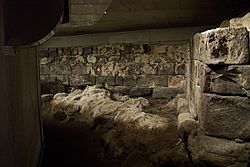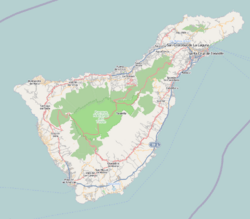Castle of San Cristóbal (Santa Cruz de Tenerife) facts for kids
Quick facts for kids Castle of San Cristóbal |
|
|---|---|
| Santa Cruz de Tenerife (Canary Islands, Spain) | |
 |
|
|
Location of the fortification on the island of Tenerife
|
|
| Coordinates | 28°28′01″N 16°14′51″W / 28.46694°N 16.24750°W |
| Site history | |
| Built | 1575–1577 |
| Fate | demolished in 1928 |
The Castle of San Cristóbal (which means Castillo de San Cristóbal in Spanish) was a very important fort in Santa Cruz de Tenerife, located in the Canary Islands, Spain. It was the first big fort built on the island of Tenerife. This castle was the main building that protected Santa Cruz Bay from attacks. Even today, a street in the city, Castle Street, is named after this famous fort.
Work on the castle began in 1575. It was officially ready for use on January 20, 1577. Sadly, the castle was taken down in 1928 to make space for the Plaza de España. For many years, the remains of the castle were hidden underground. But on June 28, 2006, during a project to fix up the Plaza de España, parts of the old castle were found! People took special care to protect these important historical pieces.
Today, you can still see some of the original castle walls. They are on display in a special tunnel located under the Plaza de España. This area is now a museum. It is home to the famous "Cañón Tigre" (Tiger Cannon). This cannon is known for shooting a musketball that hit Rear-Admiral Horatio Nelson's right arm on July 25, 1797. The injury was so bad that Nelson had to have his arm removed.
Contents
Why Was the Castle Built?
The Castle of San Cristóbal was built to be the main defense for Santa Cruz. Construction started on December 15, 1575. By 1577, the local government had moved cannons and other weapons into the fort. The island's governor at the time, Juan Alvarez de Fonseca, started the building project. The castle was built on a rocky area in Bias Diaz Cove. It was shaped like a square, with strong walls at each corner.
Famous Battles and the Castle
The castle played a key role in several important battles:
- It helped defend against Admiral Blake's attack on April 30, 1657.
- It was involved in the fight against Admiral Jennings on November 6, 1706.
- It was also part of the defense against Admiral Nelson's attack on July 25, 1797.
Besides being a fort, the castle was also where the main military leaders and governors lived. It was the center of the military government for the island.
The Castle's End and Rediscovery
The Castle of San Cristóbal was torn down in 1928. Even though the castle was gone, people remembered it. That's why "Calle Castillo," or Castle Street, in Santa Cruz still carries its name.
In 2006, the Plaza de España was being updated. In June of that year, workers found the remains of the castle. Because these remains were so important to history, the plans for the new plaza were changed. An underground area was created to show off the castle's remains. Also, an outline of the castle was added to the bottom of the plaza's lake.
Today, the parts of the castle found under the Plaza de España are protected. You can visit one corner of the castle that remains. There's also a small exhibit run by Museos de Tenerife.
On July 25, 2009, the famous El Tigre cannon was placed in its own special room at the center. This bronze cannon was made in Seville in the 1700s. It is 3 meters (about 10 feet) long and weighs 2,000 kilograms (about 4,400 pounds). Many believe this is the exact cannon that injured Admiral Nelson during the Battle of Santa Cruz de Tenerife (1797).
See also
 In Spanish: Castillo de San Cristóbal (Santa Cruz de Tenerife) para niños
In Spanish: Castillo de San Cristóbal (Santa Cruz de Tenerife) para niños


